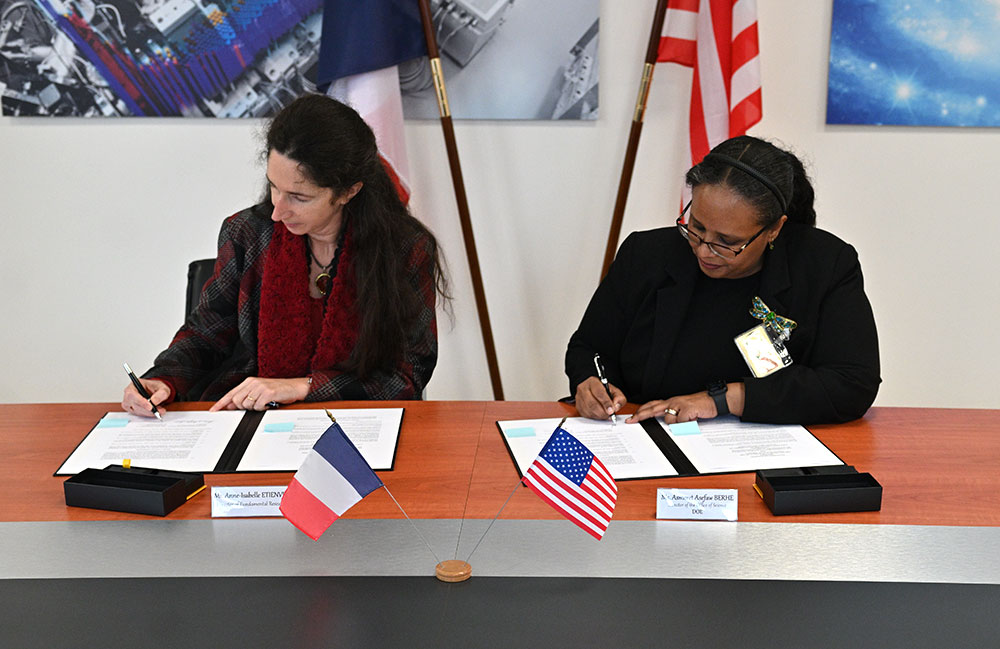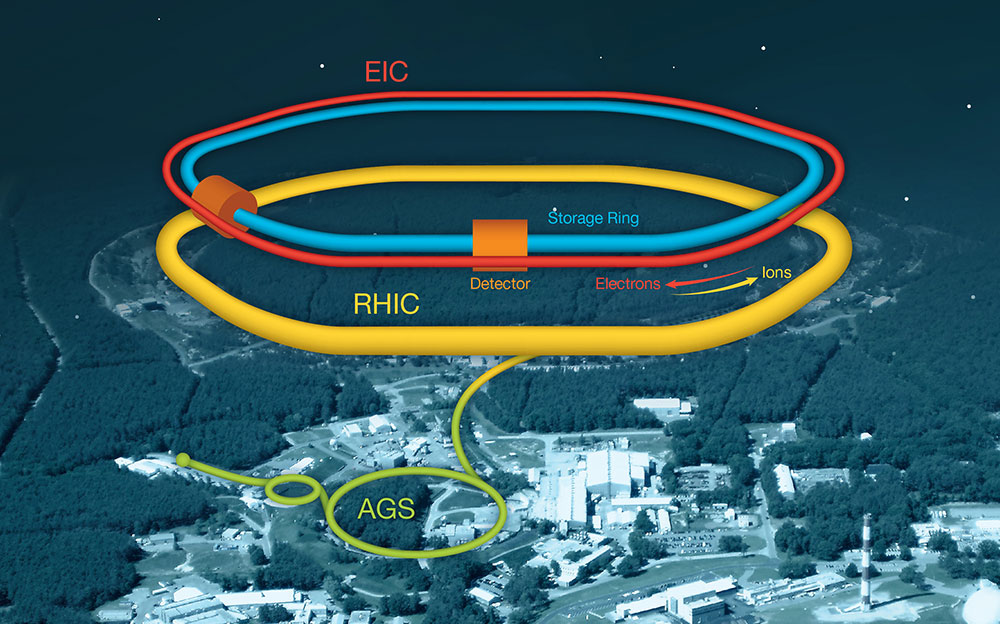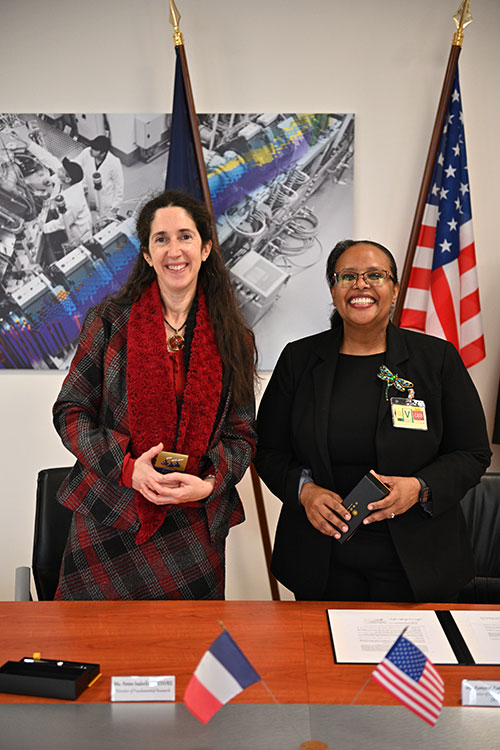French and U.S. Science Agencies Take First Step to Collaborate on Electron-Ion Collider (EIC)
U.S. Department of Energy and French Alternative Energies and Atomic Energy Commission sign "Statement of Interest" on EIC
November 13, 2023
 enlarge
enlarge
Anne-Isabelle Etienvre, director of the fundamental research division of CEA, and Asmeret Asefaw Berhe, director of the DOE Office of Science, sign an official "Statement of Interest" to launch what both agencies hope will be a significant collaboration on the Electron-Ion Collider. (X.Coppolani/CEA)
PARIS, NOV. 13—Representatives from the U.S. Department of Energy’s (DOE) Office of Science and the French Alternative Energies and Atomic Energy Commission (CEA) have signed a “Statement of Interest” to launch what both agencies hope will be a significant collaboration on the Electron-Ion Collider (EIC). The EIC, being built in the U.S. at DOE’s Brookhaven National Laboratory in partnership with DOE’s Thomas Jefferson National Accelerator Facility (Jefferson Lab), will be a unique facility for exploring the building blocks of matter and the strongest force in nature. The agreement continues a long history of cooperation in scientific endeavors between the governments of France and the U.S. and is a first step toward forging stronger collaborative ties and future French contributions to the EIC.
“The Department of Energy and The French Alternative Energies and Atomic Energy Commission (CEA) have a rich history of scientific and technological cooperation spanning many fields and projects,” said Asmeret Asefaw Berhe, director of the DOE Office of Science. “We are currently working together on collaborations related to fusion, high energy physics, and nuclear physics. Today, we sign a Statement of Interest to strengthen our joint interest in exploring a new frontier in accelerator and detector science and technology together, on the road to construction of the Electron-Ion Collider. We are looking forward to continuing our relationship with CEA and exploring how we can collaborate in the future.”
“Indeed, CEA and DOE have a long tradition of scientific and technological cooperation,” said Franck Sabatié, director of the Institute for Research into the Fundamental Laws of the Universe of CEA. “The Statement of Interest we signed today describes our reinforced cooperation in accelerator and detector science and technology, paving the way towards the construction of the Electron-Ion Collider. We are delighted to have hosted the DOE delegation today and wish to express our strong interest in continuing our productive relationship with DOE and exploring new avenues of collaboration in the future.”
 enlarge
enlarge
A schematic perspective of the how the Electron-Ion Collider (EIC) will add electron accelerator and storage rings to the existing Relativistic Heavy Ion Collider (RHIC) at Brookhaven National Laboratory. French and U.S. science agencies have expressed interest in collaborating on accelerator and detector science and technology and the scientific research at the EIC.
One-of-a-kind collider
The EIC is the only collider planned to be constructed anywhere in the world in the next decade—and the first to collide a beam of high-energy polarized electrons with a counter-circulating beam of high-energy polarized protons or heavier ions. A sophisticated detector will capture snapshots of these collisions to reveal how the particles and forces at the heart of atomic nuclei build up the structure and properties of everything we see in the universe today—from stars to planets to people.
In October, the U.S. Nuclear Science Advisory Committee recommended “the expeditious completion of the EIC as the highest priority for facility construction” in its 2023 Long Range Plan. In addition, this research endeavor has attracted broad international engagement with a worldwide community of potential EIC researchers numbering more than 1,400.
“We are delighted that the CEA is expressing an interest in being part of the EIC,” said Brookhaven National Laboratory Director JoAnne Hewett. “Given the scale of this project and the importance of the science to the world, it is vital that it be a truly international project and that the best and brightest minds are brought to bear on building this exciting machine. The signing ceremony today is an important step in achieving that vision.”
CEA researchers have been actively involved with the EIC project since its early days, when they contributed to the preparation of the science case for the EIC, including white papers, reports, and detector proposals. Outside of the U.S., France is one of the largest members the EIC Users’ Group with 44 members in five institutions. CEA has previously constructed detectors for the CLAS12 experiment at Jefferson Lab, as well as portions of the sPHENIX detector at Brookhaven Lab’s Relativistic Heavy Ion Collider (RHIC). CEA scientists have also made contributions to RHIC’s PHENIX experiment.
The agreement signed today specifically expresses interest in cooperation among the French and American science agencies on the groundbreaking accelerator and detector science and technology needed to realize the promise of the EIC. Continued CEA research and development for the EIC detector would include development of application-specific integrated circuits (ASICs) for use in analyzing the large volumes of data and signals that will be produced in the EIC. In addition, CEA physicists are currently collaborating with Jefferson Lab on preliminary designs for a superconducting solenoid magnet that would form the core of the EIC detector. And CEA accelerator scientists are working on designs for spin rotator magnets, components within the accelerator of the EIC that are necessary for controlling the polarization of the colliding particles.
The agencies also expressed interest in having scientific and technical staff from DOE national laboratories and U.S. universities and from French research laboratories and universities participate in nuclear physics projects and other activities associated with the EIC. These would include the EIC’s experimental program to unravel the structure of atomic nuclei and understand how the mass and spin of its protons and neutrons arise from particles called quarks and gluons, the fundamental building blocks whose interactions will be revealed by the EIC.
“CEA researchers and technologies have long contributed to progress in nuclear physics research efforts, including international experiments that are ongoing here in the U.S.," said Jefferson Lab Director Stuart Henderson. “The realization of the EIC’s ambitious scientific goals will not only help advance the field of nuclear physics, but also the research technologies that lead to applications that are beneficial to society.”
Benefits beyond physics
The EIC will significantly advance accelerator and particle detector technology with potential benefits for many other fields important for economic development and improving quality of life:
- New medical isotopes and particle beam approaches for diagnosing and treating cancer
- Artificial intelligence and other computational tools for simulating climate change, tracking global pandemics, and protecting national security
- Accelerator advances for making and testing computer chips, studying proteins and therapeutic drugs, designing better batteries, and more
- Development of radiation-resistant materials for energy applications
- Hundreds of highly skilled jobs and training for a future tech-savvy workforce
The $1.7-2.8 billion EIC project is well into the planning stages at Brookhaven Lab. The baseline cost and schedule for EIC construction is planned to be decided in FY 2025 with facility operations to begin in the early 2030s.
Brookhaven National Laboratory is supported by the Office of Science of the U.S. Department of Energy. The Office of Science is the single largest supporter of basic research in the physical sciences in the United States and is working to address some of the most pressing challenges of our time. For more information, visit science.energy.gov.
Follow @BrookhavenLab on social media. Find us on Instagram, LinkedIn, Twitter, and Facebook.
Jefferson Science Associates, LLC, manages and operates the Thomas Jefferson National Accelerator Facility, or Jefferson Lab, for the U.S. Department of Energy's Office of Science. JSA is a wholly owned subsidiary of the Southeastern Universities Research Association, Inc. (SURA).
2023-21562 | INT/EXT | Newsroom










